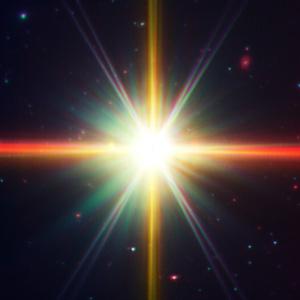The image below is Epsilon Eridani, some 10.5 light years from Earth, as seen in the infrared by the Spitzer Space Telescope. We have evidence of the existence of at least one planet around the star, orbiting at 3.4 AU, but subsequent attempts to detect other planets have thus far failed. However, a debris disk, detected at radio frequencies, is known to exist, and it provides evidence of other planets based on perturbations in the dust and rocks of the disk itself. Epsilon Eridani is a comparatively young star (730 million years old), and so provides a useful case study of a solar system in formation.
 The Spitzer photograph comes courtesy of Massimo Marengo, who heads a team that is using the Spitzer instrument to detect Epsilon Eridani’s unseen companions. In this ongoing study, working especially with Spitzer’s Infrared Array Camera (IRAC), the team has developed methods of light subtraction that can suppress most of the light from the central star, allowing the detection of objects much dimmer than ever found before. The analysis of this extensive data is ongoing.
The Spitzer photograph comes courtesy of Massimo Marengo, who heads a team that is using the Spitzer instrument to detect Epsilon Eridani’s unseen companions. In this ongoing study, working especially with Spitzer’s Infrared Array Camera (IRAC), the team has developed methods of light subtraction that can suppress most of the light from the central star, allowing the detection of objects much dimmer than ever found before. The analysis of this extensive data is ongoing.
Meanwhile, we have this gorgeous image of Epsilon Eridani, which Marengo (Harvard-Smithsonian Center for Astrophysics) used in a poster presentation at the recent American Astronomical Society meeting in San Diego. This is a false-color composite image: the red, yellow, green and blue colors represent different wavelengths in the thermal infrared, a part of the spectrum invisible to the human eye. This is where the Spitzer instrument excels, as working with infrared wavelengths increases the chances of viewing objects otherwise lost in the star shine, and culling planets out of the background stars and galaxies.
Marengo notes that the orange and red ‘cross’ is the result of electronic artifacts in the detector, while the blue and green spikes result from the diffraction of starlight in the telescope optics. And note the colored dots, which are the objects of interest. From Marengo’s weblog: “Once the light of the bright star is removed, I can identify the nature of the remaining specks of light in the image on the basis of their color (for example, the red fuzzy dots are background spiral galaxies, whose red color is due to the emission of special organic molecules whose stellar forming regions are generally rich).”
The poster presentation created by Marengo’s team, “A Search for Substellar Companions of the Debris Disk Star ε Eridani with the Spitzer Space Telescope,” can be found here. A proceeding paper reporting on the status of this work will appear in Marengo et al., The Spitzer Space Telescope: New Views of the Cosmos (ASP Conference Series; now in press), with a subsequent paper in the Astrophysical Journal. Also see Hatzes, et al., “Evidence for a Long-period Planet Orbiting Epsilon Eridani,” Astrophysical Journal Letters, 544, L145 (2000).

